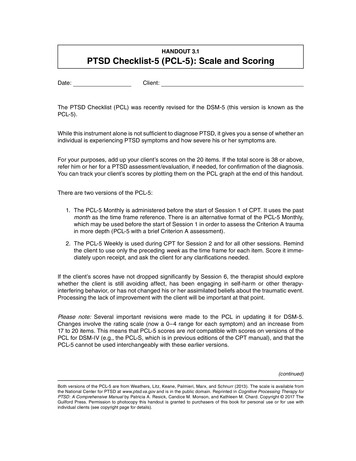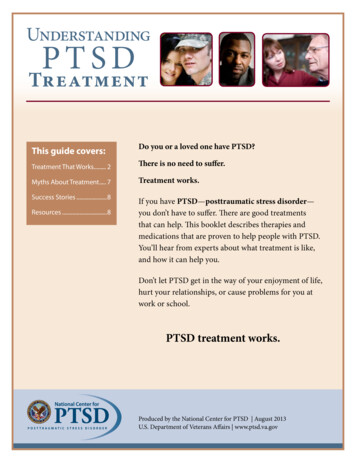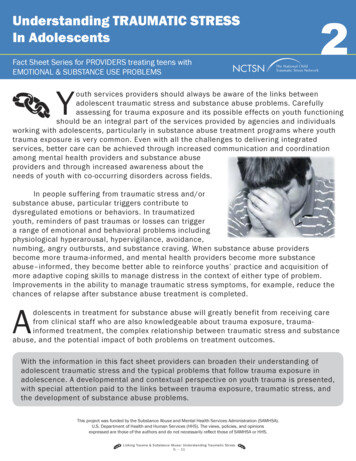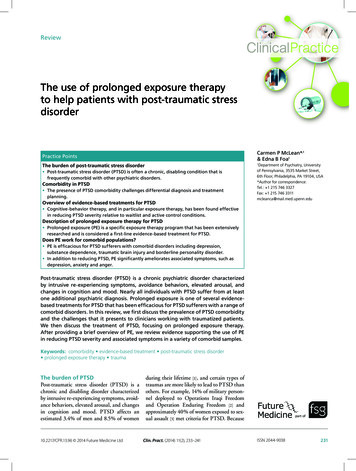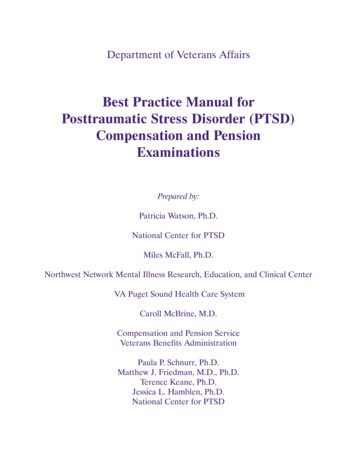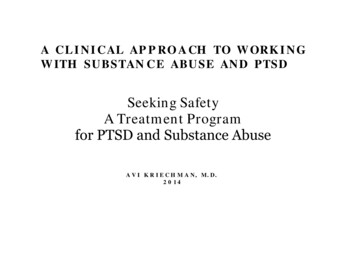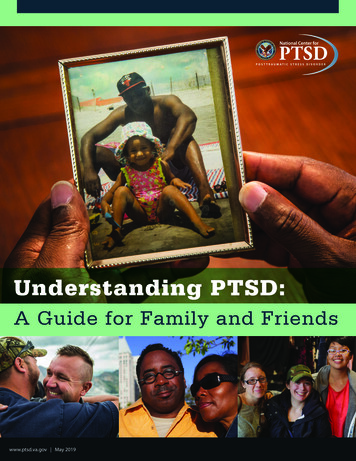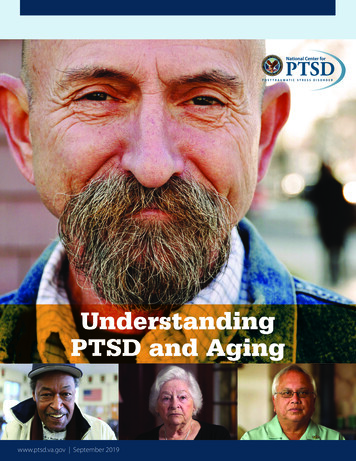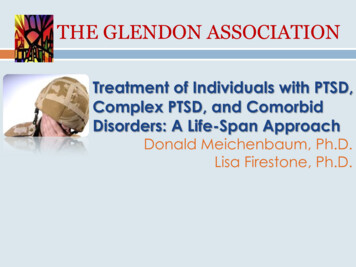
Transcription
THE GLENDON ASSOCIATIONTreatment of Individuals with PTSD,Complex PTSD, and ComorbidDisorders: A Life-Span ApproachDonald Meichenbaum, Ph.D.Lisa Firestone, Ph.D.
Donald Meichenbaum, Ph.D.Lisa Firestone, Ph.D.Professor Emeritus at the University ofWaterloo, OntarioResearch Director of The Melissa InstituteFellow of the American and CanadianPsychological AssociationsCo-Founder Cognitive Behavior TherapyDirector of Research andEducation at The don.orgwww.psychalive.org
POLL 1Have you seen or heard ofDr. Meichenbaum before?
Conceptualization of PTSD Issues concerning Criterion Issues of “Criterion-creep” Most individuals (70% ) do not develop PTSD Question Diagnostic Criteria A2- - involving fear, horror andhelplessness Issue of symptom overlap and comorbidity Little evidence of delayed onset PTSD No evidence of special mechanisms of traumatic memories, norclaims of “body memories”Search for biological markers has not proven successful.Need for cultural/racial, gender and developmental factors inassessment and treatment
Treatment Issues Equivalent Outcomes of Treatments for PTSD and Complex PTSD. Dismantling studies fail toidentify active ingredients DTE, CPT, PCS, EMDR, as examples). Consideration of ACRONYM THERAPIES Integrated Treatments for Patients with Comorbid Disorders Target-specific Interventions Spiritually-oriented Treatments and other treatment approaches Pharmacotherapies - have yielded limited positive results.
Treatment IssuesTreatments to Avoid CISD, Psychoeducational Interventions, “Energy-based”treatments such as Thought Field Therapy, TraumaIncident Resolution, Visual Kinesthetic Dissociation,Recovery-based Interventions, age regression, certainforms of grief counselling
How to Spot “Hype” InPsychotherapy PresentationPresentation style; “Tricks of the trade” to oversellinterventions; Check the nature of the ComparisonGroups in Randomized Controlled Studies; Issues ofBonafide Treatments; Allegiance Effects; The“packaging” of interventions.
Implications for the Treatment of Individuals withPTSD, Complicated PTSD and ComorbidPsychiatric Disorders What distinguishes those who develop chronic disordersversus those who evidence Resilience? Implications fortreatment?What are the common core competencies that cut acrossdiverse interventions?What barriers interfere with the Natural Recovery processand how can these be anticipated and addressed?Critical role of a Case Conceptualization Model thatinforms ongoing assessment/evaluation and need forintegrated treatment decision-making?Need for culturally, racially, gender and developmentallysensitive interventions.How to become a “critical consumer” of thepsychotherapy field? How not to be persuaded by “hype.”
“HOW TO” DEVELOP PERSISTENT PTSD andRELATED ADJUSTMENT PROBLEMSAt the Cognitive Level Engage in self-focused, “mental defeating” type of thinking.See self as a “victim”, controlled by uninvited thoughts, feelingsand circumstances, continually vulnerable, unlovable,undesirable, unworthy - “Contaminated,” “Damaged goods”Hold erroneous beliefs that changes are permanent, the worldis unsafe, unpredictable and that people are untrustworthy.Hold a negative, foreshortened view of the future and thebelief that life has lost its meaningEngage in self-berating, self-condemnation, self-derogatory“story-telling” to oneself and to others (i.e., self blame, guiltengendering hindsight, biased thinking; anger-engenderingthoughts of viewing provocations as being done “on purpose”)Engage in upward social comparisonsRuminate repeatedly
“HOW TO” DEVELOP PERSISTENT PTSD andRELATED ADJUSTMENT PROBLEMSAt the Cognitive Level Engage in contra-factual thinking -“Why me” and “Only if”Engage in avoidant thinking processes of deliberately suppressingthoughts, using distracting behaviors, using substances; avoidant copingbehaviors and dissociation.Have an overgeneralized memory and recall style which intensifieshopelessness and impairs problem-solving.Engage in “thinking traps”. For example, tunnel vision as evident in thefailure to believe anything positive could result from trauma experience;confirmatory bias as evident in the failure to retrieve anything positiveabout one’s self-identityEvidence “stuckiness’” in one’s thinking processes and behavior. Respondto new situations in post-deployment settings “as if” one was still in combat(misperceive threats).
“HOW TO” DEVELOP PERSISTENT PTSD andRELATED ADJUSTMENT PROBLEMSAt the Emotional Level Engage in emotional avoidance strategies Magnify and intensify your fears and anger Experience guilt (hindsight bias), shame,complicated grief, demoralizationFail to engage in grief work that honors andmemorializes loved ones or buddies who were lostFail to share or disclose feelings, process traumaticmemories
“HOW TO” DEVELOP PERSISTENT PTSD andRELATED ADJUSTMENT PROBLEMSAt the Behavioral Level Engage in avoidant behaviors of trauma-relatedfeelings, thoughts, reminders, activities andsituations; dissociating behaviorsBe continually hypervigilantEngage in safety behaviors that interfere with thedisconfirmation of emotional beliefsEngage in delay seeking behaviors. Avoid seekinghelp. Keep secrets and “clam up” Engage in high risk-taking behaviors Engage in health-compromising behaviors Engagement in self-handicapping behaviors Use passive, disengaged coping behaviors
“HOW TO” DEVELOP PERSISTENT PTSD andRELATED ADJUSTMENT PROBLEMSAt the Social Level Withdraw, isolate oneself, detach from othersPerceive yourself as being unwanted, a “burden”,thwarted belongingness, distrusting others (“No onecares”, “No one understands,” “No one can betrusted.”)Associate with peers and family members whoreinforce and support maladaptive behaviors. Putyourself in high-risk situationsExperience an unsupportive and indifferent socialenvironmentFail to seek social support or help, such as peerrelated groups or professional assistance
“HOW TO” DEVELOP PERSISTENT PTSD andRELATED ADJUSTMENT PROBLEMSAt the Spiritual Level Fail to use your faith or religion as a means of coping Have a “spiritual struggle” Use negative spiritual coping responses Experience “moral injuries” that compromise valuesAvoid contact with religious members who can be supportive
Psychological Characteristicsof Resilient IndividualsExperience Positive Emotions and Regulate StrongNegative Emotions Be realistically optimistic, ability to laugh at oneself, humor, faceone’s fears. Positive expectations about the future. Positive selfimage. Build on existing strengths, talents and social supports.Adapt a Task-Oriented Coping Style Present-focused, acceptance, actively seek help and garnersocial supports, have a resilient role model, have self-efficacy,self confidence, seek out new and challenging experiences,evidence “GRIT.”Be Cognitively Flexible Reframe, redefine, restory, find benefits, engage in socialproblem-solving.Undertake a Meaning-Making Mission Create meaning and a purpose in life. Use one’s faith,spirituality, and values as a “moral compass.” Be altruistic andmake a “gift” of one’s experience. Share one’s story.Keep Fit and Safe Exercise, reduce risks, avoid unsafe high-risk behaviors
CORE TASKS OF PSYCHOTHERAPY:WHAT “EXPERT” THERAPISTS DO BASED UPONTHERAPEUTIC PRINCIPLES OF CHANGE1. Develop a collaborative therapeutic relationship/allianceand help the patient "tell“ his/her story. After listeningattentively and compassionately to the patient’s distress and“emotional pain”, help the patient identify "strengths" andsigns of resilience. "What did he/she accomplish in spite of.?" "How was this achieved?" Use Socratic Questioning.i.Foster bonding between patient and therapist. Address anyruptures or strains in the alliance and address any therapyinterfering behaviors.ii.Collaborate with the patient in establishing treatment goalsand the means to achieve these goals.iii.Encourage the patient’s motivation to change and promotethe patient’s belief that therapy can help. (Use MotivationalInterviewing Procedures).iv.Monitor the patient’s progress and use the information toguide ongoing treatment.2. Be culturally-sensitive
CORE TASKS OF PSYCHOTHERAPY:WHAT “EXPERT” THERAPISTS DO BASED UPONTHERAPEUTIC PRINCIPLES OF CHANGE3. Educate the patient about his/her problems and possiblesolutions and facilitate awareness. Use various ways toeducate and nurture a sense of curiosity and discovery.i.Conduct Risk and Protective Factors assessment and provideconstructive feedback.ii.Use a Case Conceptualization Model and share therapyrationale.iii.Have the patient engage in self-monitoring.iv.Use videotape modeling films and other educational materials.v.Use a “Clock metaphor” – “Vicious Cycle” Model (see nextslide)vi.Therapist models thinking: Ask the patient: “Do you ever findyourself, out there, in your day-to-day experience, askingyourself the kind of questions that we ask each other righthere?”vii. Educate the patient about relapse prevention strategies.
CORE TASKS OF PSYCHOTHERAPY:WHAT “EXPERT” THERAPISTS DO BASED UPONTHERAPEUTIC PRINCIPLES OF CHANGE“Clock metaphor” – “Vicious Cycle” Model12 o'clock - external and internal triggers3 o'clock - primary and secondary emotions6 o'clock - automatic thoughts, thinking patterns and schemas or beliefs9 o'clock - behaviors and resultant consequences“It sounds like this is just a vicious (without completing the sentence) allowing the patient to interject"cycle or circle.” To which the therapist can then say, “In what way is this a vicious cycle? Are yousuggesting.?”His/her appraisal of situations, feelings, thoughts, and behaviors are all interconnected.“Collect data” (self-monitor).“If you (the patient) are engaging in such cyclical behaviors, then what is „the impact, what is the toll,what is the emotional and behavioral price that you are paying? Is that the way you want things to be?If not, then what can you do about it?”“Break the cycle.” What did you have in mind?”, the therapist can ask. The therapist can help thepatient come to appreciate how he/she has already been trying to “break the cycle.”Primary and secondary emotions“What do you do with all those feelings (emotions)?”What is the impact, the toll, the price he/she and others pay? Is that the way he or she wants things tobe? If not, then what can be done about it?” - “art of Socratic questioning”
CORE TASKS OF PSYCHOTHERAPY:WHAT “EXPERT” THERAPISTS DO BASED UPONTHERAPEUTIC PRINCIPLES OF CHANGE4. Help the patient reconceptualize his/her "problems" in a more hopeful fashion.i.Do a life-review (Use Time-lines – see next slide)ii.Use collaborative goal-setting (short-term, intermediate, long-term goals)iii.Use videotape coping modeling filmsiv.Use letter-writing, journalingv.Use group processes – open-ended groupsvi.Use Alumni clubs of successful patients (coping models)vii. Use hope-engendering mentors
CORE TASKS OF PSYCHOTHERAPY:WHAT “EXPERT” THERAPISTS DO BASED UPONTHERAPEUTIC PRINCIPLES OF CHANGETimelines:Timeline 1 – Birth to present. Note stressors and various treatments.Timeline 2 – Birth to present. Note “strengths” and “In spite of” and use“How” and “What”questions.Timeline 3 – Present into futureHighlight: How things are now and how would the patient like them tobe in the future?The therapist can go on to ask:“What can we do to help you achieve your goals of ? What haveyou tried in the past to achieve your goals of ? What has worked?What has not worked, as evident by ?”“If we worked together, and I hope we will, how would we know ifyou were making progress? What changes would someone elsenotice in your behaviors?”“Let me ask one more question, if I might. Can you foresee orenvision anything that might get in the way or act as a barrier orobstacle to your achieving ? What do you think could be done toanticipate and address such potential barriers?”
CORE TASKS OF PSYCHOTHERAPY:WHAT “EXPERT” THERAPISTS DO BASED UPONTHERAPEUTIC PRINCIPLES OF CHANGE5. Ensure that the patient has intra- and interpersonal coping skillsi.Highlight the discrepancy between valued goals and current behavior andconsequences and consider what can be done to close this gap.ii.Train and nurture specific skills to the point of mastery.iii.Build in generalization.iv.Put the patient in a consultative mode.6. Encourage the patient to perform "personal experiments"i.Solicit change talkii.Facilitate “corrective emotional experiences”iii.Involve significant others.iv.Ensure that the patient takes the "data" to unfreeze his/her beliefs.
CORE TASKS OF PSYCHOTHERAPY:WHAT “EXPERT” THERAPISTS DO BASED UPONTHERAPEUTIC PRINCIPLES OF CHANGE7. Ensure that the patient takes credit for changei.Use attribution trainingii.Nurture a sense of mastery and efficacy (“In spite of How ?”)iii.Monitor the degree to which the patient ascribes personal agencyfor change.iv.Help the patient change his/her personal narrative8. Conduct relapse preventionAdditional Psychotherapeutic Tasks for Treating Psychiatric PatientsWitha History of Victimization.9. Address basic needs and safety - symptom regulationi.Conduct an integrated treatment programii.Normalize, validate and reframe symptoms as a means of coping
CORE TASKS OF PSYCHOTHERAPY:WHAT “EXPERT” THERAPISTS DO BASED UPONTHERAPEUTIC PRINCIPLES OF CHANGE10. Address "memory work" and help with the patient’sbelief systemi.“Retelling" trauma storyii.Relive with cognitive restructuringiii.Consider what implications (beliefs) the patient has drawniv.Consider impact of "shattered assumptions”11. Help the patient find "meaning": Adopt a constructivenarrative perspectivei.Consider what the patient did to "survive"ii.What evidence of strengths in self and in othersiii.What "lessons" learned that the patient can share withothersiv.What is the role of faith
CORE TASKS OF PSYCHOTHERAPY:WHAT “EXPERT” THERAPISTS DO BASED UPONTHERAPEUTIC PRINCIPLES OF CHANGE12. Help the patient re-engage and "reconnect"with others.i.How to move beyond the "victim" role to that ofbecoming a “survivor”,even a “thriver”ii.How to engage in a proactive "helper" roleiii.How to connect with adaptive/supportive peersand community resources13. Religion or spirituality14. Help the helpers. “Expert” psychotherapistsmonitor, assess and attend to the impact ofvicarious traumatization.
GENERIC CASE CONCEPTUALIZATION MODEL1A. BackgroundInformation1B. Reasons forReferral9. Barriers9A. Individual9B. Social9C. Systemic2A. Presenting Problems(Symptomaticfunctioning)2B. Level of Functioning(Interpersonalproblems, Social roleperformanceperformance)8 Outcomes (GAS)8A. Short-term8B. Intermediate3. Comorbidity3A. Axis I3B. Axis II3C. Axis III8C. Long-term7. Summary Risk andProtective Factors6. Strengths6A. Individual6B. Social6C. Systemic5. Treatments Received(Current/Past)5A. Efficacy5B Adherence5C. Satisfaction4. Stressors(Present/Past)4A. Current4B. Ecological4C. Developmental4D. Familial
BOXES 1& 2: REFERRAL SOURCES &PRESENTING PROBLEMS“What brings you here is .?“And is it particularly bad when.”“But it tends to improve when you.”“And how is it affecting you?”
BOX 3: COMORBIDITY“In addition, you are also experiencing.”“And the impact of this in terms of your dayto-day experience is.”
BOX 4: STRESSORS“Some of the factors (stresses) that you are currentlyexperiencing that seem to maintain your problemsare.”“And it's not only now, but this has been going on forsome time, as evident by.”“And it's not only something you have experienced,but your family members have also beenexperiencing.”“And the impact on you has been.”
BOX 5: TREATMENT RECEIVED“For these problems the treatments that you havereceived were.”“And what was most effective?”“But you had difficulty following through with thetreatment as evident by.”“And some of the difficulties (barriers) in followingthe treatment were.”“But you were specifically satisfied with.”
BOX 6: STRENGTHS“But in spite of.you have been able to.”“Some of the strengths.”“Moreover, some of the people (resources) you can call upon(access)are.”“And they can be helpful by doing.” (Social supports)
BOX 7: SUMMARY OF RISK ANDPROTECTIVE FACTORS“Have I captured what you were saying?”“Of these different areas, where do youthink we should begin?”
BOX 8: OUTCOMES (GOALATTAINMENT SCALING PROCEDURES)“Let's consider what are your expectations about the treatment.“How are things now in your life? How would you like them to be?”“How can we work together to help you achieve these short-term,intermediate, and long-term goals?”“What has worked for you in the past?”“How can our current efforts be informed by your past experience?”“Moreover, if you achieve your goals, what would you see changed?”“Who else would notice these changes?”
BOX 9: POSSIBLE BARRIERS“Let me raise one last question, if I may. Can youenvision, can you foresee, anything that might get inthe way?”“Let's consider how we can anticipate, plan for, andaddress these potential barriers.”“Let us review once again.”Reassess with the patient the treatment planthroughout treatment.
POLL 2Do you think this approach tocase conceptualization could bebeneficial for your clients? And for youin planning effective interventions? Very helpful Somewhat helpful Not helpful
OVERVIEW OF TREATMENTINITIAL PHASE I Establish, maintain and monitor therapeutic alliance. Address therapy interferingbehaviors and potential barriers. Ensure client safety: Ongoing Risk assessments and assess for comorbid disorders. Address immediate needs and provide assistance. Normalize and validate client’s experiences. Educate the client about presenting problems and about treatment. Nurture Hope. Use Time Lines and related procedures. Collaboratively generate “SMART” treatment goals.PHASE II Address target symptoms of PTSD and Complex PTSD. Address comorbid-disorders in an integrated treatment fashion. Teach and nurture intra and interpersonal coping skills. Focus on Affect Regulation Skills. Bolster resilience-engendering behaviors Address treatment adherence issues.
OVERVIEW OF TREATMENTPHASE III Address issues of traumatic memory and meaning-making. Use exposure-based interventions. Use Cognitive Reconsideration and Cognitive-restructuring Help develop “Healing Stories.” Use spiritually-oriented interventions. “Meaning-making” activities. Help the client develop and mobilize supportive relationships. “Connectedness”PHASE IV Use client Checklists and nurture self-attribution processes. Re-visit Relapse Prevention procedures. “Anniversary effects”. Build in follow-up and follow-through procedures. Ensure continuity of care. Bolster Health Care Procedures’ Resilience: Help the Helpers
POLL 3Do you help your clients createhealing stories? Yes, most of the time Yes, sometimes No
HOW TO CREATE A “HEALING STORY”We don‟t just tell stories, stories tell us. The tales we tell hold powerfulsway over our memories, behaviors and even identities1. Their traumatic narrative is inadequately integrated into their autobiographical memories. “Hot spots” and “stuck points” BACKFIRE and BOOMERANG2. RESILIENT - psychologically agile and flexible in howthey tell their stories.3. Resilient individuals may take some time to experiencegrief or unhappiness, distress, anger and loss, sadness andanxiety which improves their abilities to better appreciatethe world in all of its complexity and richness.4. Resilient individuals - redemptive sequences vs.contamination sequences5. Resilient individuals slow down - break their experiences into pieces.6. Resilient individuals - “open spaces” - guide to new goals and alternatives. Redemption storiesbolster hope.
HOW TO CREATE A “HEALING STORY”7. Resilient individuals - COHERENT STORIES that create meaning out of their stressfullife experiences and in which they see themselves as “personal agents”, often withthe assistance of others, of the positive changes that they have been able to bringabout. These COHERENT NARRATIVES are 1. clearly articulated 2. detailed 3. logicaland well organized. Such COHERENT stories are salutary and help reduce distress.They increase the survivor’s sense of control over his or her experiences, reducesfeelings of chaos and increases the sense that the world is predictable. Provide“closure.”8. Resilient individuals have the ability and penchant to tell their fragmented stories ina chronological narrative with a before, middle and post-trauma exposure or postdeployment parts. They are able to integrate what happened during deploymentinto their autobiographical memory and let the “past be the past.”9. Resilient individuals avoid “thinking traps.” Instead they incorporate in their story-telling “cherished recollections,”“fond memories,”a “heritage of remembrances,”“change talk,” “lessons learned.”
HOW TO CREATE A “HEALING STORY”10. Resilient individuals tell their stories first and then they live their way into them. Theymay act “as if” they are characters in the stories that they tell. There may be acertain amount of “fake it, until you make it.”11. Do your stories include: Redemptive (positive ending) sequences; RE-words and change talk action verbs; Goal statements and “how to” pathways thinking Problem-solving strategies Expressions of optimism Meaning-making statements (“Making a gift”, “Sharing lessons learned” statements)?
POLL 4Do you create a resiliencechecklist for your clients? Yes, most of the time Yes, sometimes No
RESILIENCE CHECKLISTMY PERSONAL RESILIENCE PLANCreating a Vision of the Future PHYSICAL FITNESS INTERPERSONAL FITNESS EMOTIONAL FITNESS THINKING FITNESS BEHAVIORAL FITNESS SPIRITUAL FITNESS
Archived CE Webinars Relationships and the Roots of ResilienceDr. Daniel Siegel (1.5 CE Credits – 35)Love in the Time of TwitterDr. Pat Love (1.5 CE Credits – 35)Innovative Approach to Treating DepressionDr. Lisa Firestone (1.5 CE Credits – 25)Conquer Your Critical Inner Voice: An Adjunct to Clinical PracticeDr Lisa Firestone (2 CEs 25)Helping Parents to Raise Emotionally Healthy ChildrenDr. Lisa Firestone(2 CEs 25)Overcoming the Fear of IntimacyDr. Lisa Firestone(2 CEs 25)Suicide: What Every Therapist Needs to KnowDr. Lisa Firestone(1.5 CEs, 25)Understanding and Assessing ViolenceDr. Lisa Firestone (1.5 CE Credits – 25)Helping Parents to Raise Emotionally Healthy ChildrenDr. Lisa Firestone (2 CE Credits – 25)All Webinars can be found at binar-series/
Upcoming WebinarsThe Critical Inner Voice That Causes DepressionTuesday, December 6, 201111:00 AM - 12:00 PM PDTLearn more or register herehttp://www.psychalive.org/2011/04/psychalive webinars/Visit www.psychalive.org for more information or to register for additional webinars.
Recommended BooksBOOK AVAILABLE from Dr. MeichenbaumClinical HandbookTreating Individuals with Anger ControlProblems and Aggressive BehaviorsPrice 65Send check directly to Dr. MeichenbaumROADMAPtoRESILIENCEDonald Meichenbaum, Ph.D.FORTHCOMING BOOK from Dr. MeichenbaumRoadmap to ResilienceBook details will be emailed to you uponavailability
Contact: Dr. Donald MeichenbaumWebsites:Don Meichenbam215 Sand Key Estates Drive earwater Fl 33767www.warfighterdiairies.orgContact: Dr. Lisa ries.orgFor Information on this Webinar contact:glendon@glendon.org800-663-5281
To receive your CE Credits for this Webinar: Upon completion of this webinar, you will receive an email with an evaluationform for you to complete and return to the CE provider PER (PsychoEducationalResources). This form can be emailed, faxed or mailed. Instructions will be given inthe email. A recording of this webinar will also be available online. Those unable to attendthis live webinar may view the recording and complete the evaluation form toreceive 1.5 CE Units. You will be receiving 2.5 CE’s upon completing the webinarand the post test material. The live webinar offers 1.5 Ces, while reading theadditional articles we will be sending you by Dr. Meichenbaum offer an additional 1CE.You will receive an email from the Glendon Association, which will include:-A satisfaction questionnaire to filled in and returned-Articles by Dr Meichenbaum to be read-Post- test, to be completed and returnedThe post test and questionnaire need to be returned to the Glendon Associationwithin 10 days(The return information will be on the email)If you have any questions please email Jina@glendon.orgCE’s are provided by PER (PsychoEducational Resources) and a certificate will bemailed to you directly from them.
Conceptualization of PTSD Issues concerning Criterion Issues of "Criterion-creep" Most individuals (70% ) do not develop PTSD Question Diagnostic Criteria A2- - involving fear, horror and helplessness Issue of symptom overlap and comorbidity Little evidence of delayed onset PTSD No evidence of special mechanisms of traumatic memories, nor
